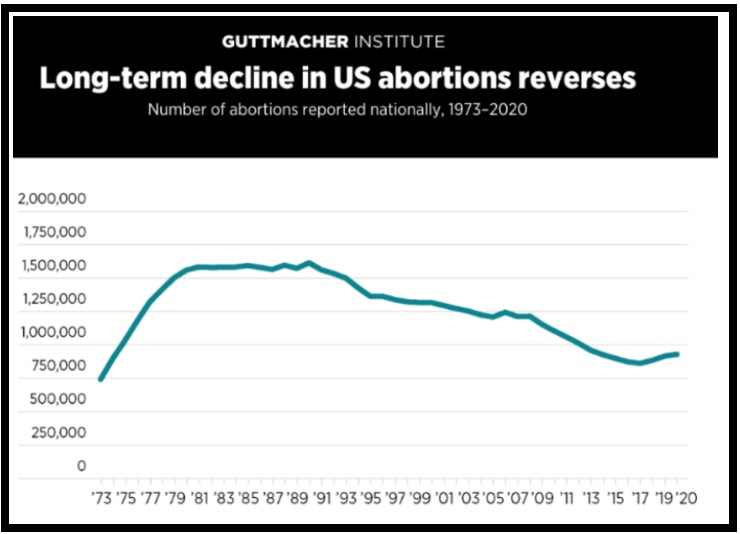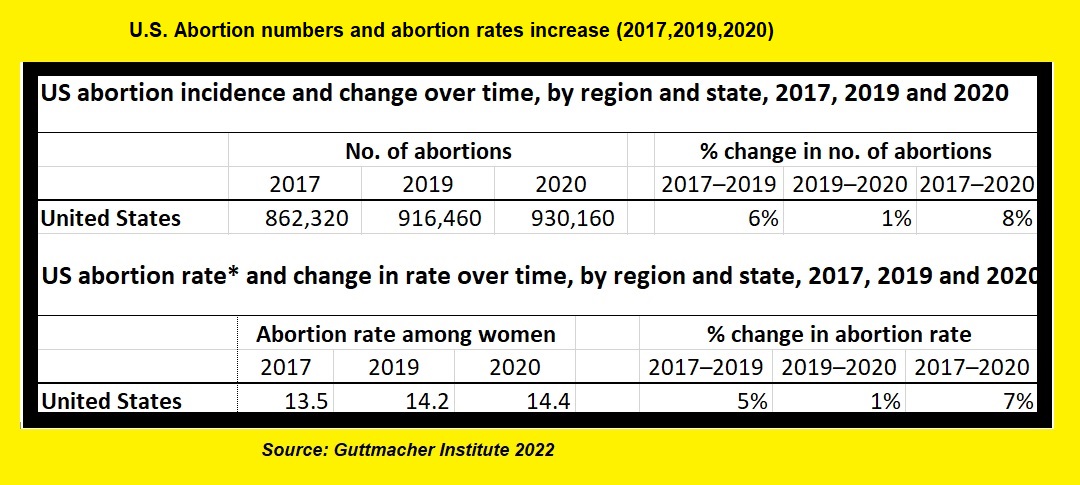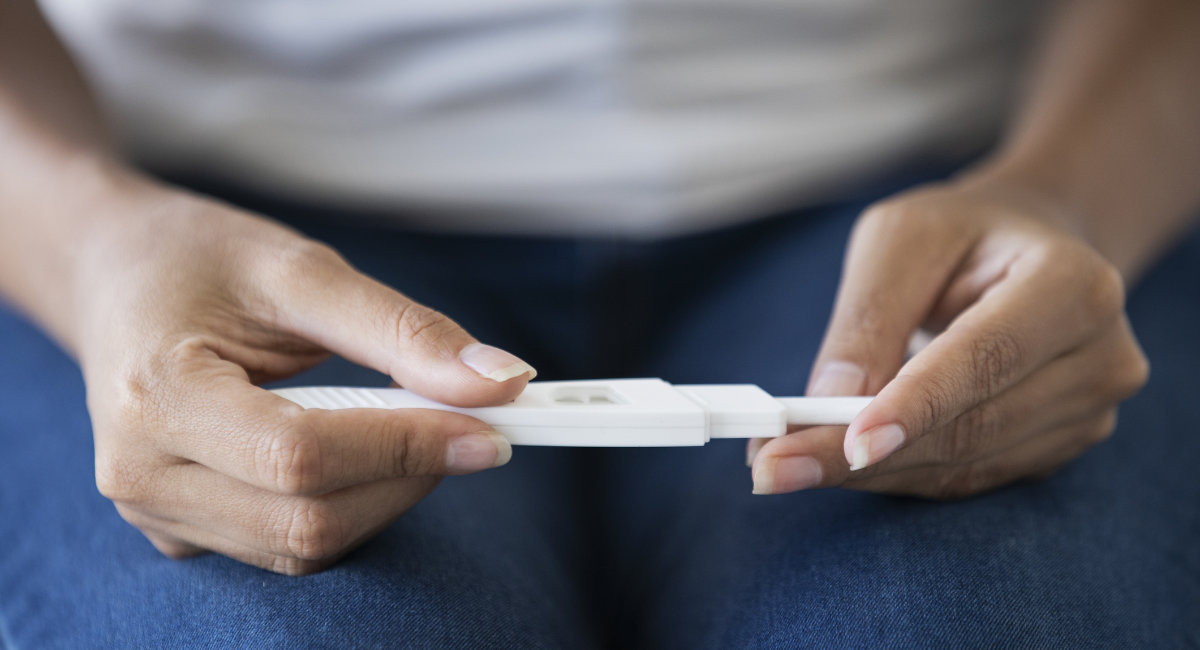Data just released by the pro-abortion Guttmacher Institute reports on the end of a long-term decline in abortions in the United States. According to Guttmacher, since the group’s last report issued in 2017, abortions have increased by nearly eight percent (7.87%), with one in five pregnancies ending in an abortion. In 2020, 930,160 abortions were committed nationally — an increase of 67,840 over the 862,320 abortions reported in 2017.
This means that today, approximately 2,548 babies are killed every day in the U.S. by abortion. That’s approximately 106 abortions per hour, 1.8 per minute, and one every 35 seconds.
Key Takeaways
- Abortions in 2020 (930,160) showed an increase of nearly 8% from 2017 — an increase of 67,840 lives lost.
- The abortion rate in 2020 (abortions per 1,000 women aged 15–44) climbed by 7% (from 13.5 in 2017 to 14.4 in 2020).
- The abortion increase was accompanied by a 6% decline in births between 2017 and 2020.
The good news: 2020 abortions still remain lower than past years
- Current numbers are 12% less than the 1,058,000 abortions reported in 2011 and 42% less than the 1,608,600 abortions committed in 1990.
- The abortion rate has dropped by 15% since 2011 (16.9 to 14.4 in 2020) and by nearly 48% from the 27.4 abortion rate reported in 1990 (27.4).
- Between 1980 and 2020, the U.S. abortion rate has fallen by over 50 percent (29.3 to 14.4).

Long term decline in abortion numbers has reverses in 2020 (Graph: Guttmacher Institute)
The former research arm and “special affiliate” of Planned Parenthood noted that the abortion rate climbed by nearly seven percent (6.66%), from 13.5 abortions per 1,000 women aged 15–44 in 2017 to 14.4 in 2020. And the abortion ratio (the number of abortions per 100 pregnancies) also increased by nearly 12% (11.95%), from 18.4% in 2017 to 20.6% in 2020. The organization notes, “Pregnancies include births and abortions but do not include miscarriages.”
“The increase in abortion was accompanied by a 6% decline in births between 2017 and 2020. Because there were many more births (3.6 million) than abortions (930,000) in 2020, these patterns mean that fewer people were getting pregnant and, among those who did, a larger proportion chose to have an abortion,” the pro-abortion group wrote, adding, “The number of abortions increased in all four regions of the country between 2017 and 2020. The rise was largest in the West (12% increase) and Midwest (10% increase); abortions increased 8% in the South and 2% in the Northeast.”
America has some of the highest abortion rates and most extreme pro-abortion laws in the world. It's time to change that. Abortion restrictions save innocent lives and we need them more than ever.#RoeMustGohttps://t.co/1x36HeRpSt
— Lila Rose (@LilaGraceRose) June 15, 2022
While the news from a frightening and difficult pandemic year is grim, the latest abortions statistics also show that 2020 abortions are lower than in years past, declining by 12% (127,840 abortions) from the 1,058,000 abortions reported in 2011 and have also sharply declined over 42% (42.17%) from the 1,608,600 abortions committed in 1990 — a difference of 648,440 babies’ lives. In addition, the abortion rate (the number of abortions per 1,000 women aged 15–44) has fallen by 15%, from 16.9 in 2011 to 14.4 in 2020 and a drastic 47.45% decrease from the 27.4 abortion rate reported in 1990.

US Abortion numbers and rate increase (2017, 2019, 2020) data: Guttmacher Institute
The latest abortion data did not update on the reasons why women choose abortion, nor did it break down abortions by race, as has been done in past reports. It also did not expound upon the previously reported increases of abortion pill sales.
In February, Guttmacher released preliminary data (from approximately 75% of US abortion facilities), which showed that the abortion pill had risen to 54% of all U.S. abortions in 2020 — indicating that today, preborn babies killed by chemical abortion pills have now climbed to well over 500,000 (502,286) annually.
READ: Former staff accuse pro-abortion Guttmacher Institute of ‘racism’ and ‘toxic workplace’
The abortion pill (Mifeprex) was approved by the Food and Drug Administration (FDA) in 2000 in what some view as a secretive process. In December of last year, the pro-abortion Biden-Harris Administration FDA weakened the safety requirements on the drug to permanently allow the abortion pill to be shipped by mail. While Guttmacher did not calculate abortion pill sales into the overall increase in abortions, some believe the perceived ease of taking a pill has led to an increase in abortions generally.
Speculated reasons for recent abortions increases
1. Medicaid expansion
Guttmacher hinted in its report that state expansion of Medicaid coverage of abortion and an increase in abortion funds to pro-abortion organizations may be driving some of the abortion increases. But while Guttmacher supports using taxpayer dollars to fund abortions, it also knows that when taxpayers fund abortion, abortions increase. And the report shows that this did, indeed, occur.
2. Increased availability of abortion pill/COVID-19 pandemic
In a Twitter thread, Dr. Michael New claimed the increases were likely due to “blue states [making] their abortion policy more permissive” as well as expanded access to the abortion pill. In addition, fear and uncertainty during the COVID-19 pandemic likely played a role. He added: “Despite this recent increase, pro-lifers have enjoyed impressive, long-term success in reducing the incidence of abortion. Between 1980 and 2020, the U.S. abortion rate has fallen by over 50 percent. A favorable ruling in Dobbs will make it possible for us to do more to protect the preborn!”
Guttmacher blames Trump policies
Guttmacher attempted to blame a pro-life Trump policy for the increases, which had prohibited Title X family planning dollars from funding abortion. The 2018 “Protect Life Rule” required abortion businesses to both fiscally and physically separate family planning/birth control services from their abortion-related business. It also stated that family planning centers must stop referring patients for abortions in order to receive Title X funding. Rather than comply with the rule change, Planned Parenthood and other abortion profiteers voluntarily refused federal funding from Title X.
Guttmacher claims this rule “dramatically slashed the Title X family planning network’s capacity and severely reduced the number of contraceptive clients served by the program. This meant that many people in some states lost access to low- or no-cost contraceptive care. In turn, this may have resulted in more unintended pregnancies and greater need for abortion care.”
In 2021, President Biden issued an executive order instructing the Department of Health and Human Services (HHS) to dismantle the protect life rule, including erasing the protections that would have kept women and girls safe from a predatory abortion industry.
Guttmacher also wrote:
Between 2017 and 2020, 25 states enacted 168 abortion restrictions and bans, but not all of them went into effect because of legal challenges. In addition, many of these new restrictions were enacted in states where clinics had already been operating in hostile environments, so their practical effect likely was reduced.
During this time period, 75 provisions to protect abortion rights were enacted. Half of these measures repealed pre-Roe bans or other restrictions. Among the other half, many expanded access by requiring Medicaid or private health plans to cover abortion, or allowing qualified clinicians such as nurse practitioners, physician assistants or certified nurse midwives to provide at least some abortion care.
“Because restrictions were adopted in states generally considered hostile to abortion rights already, they may not have played as much of a role as the measures expanding access, particularly policies that help people pay for abortion care,” the pro-abortion organization added.
Live Action founder and president Lila Rose responded to the Guttmacher report in a press release:
Nearly a million American children won’t be here to see [] their first words or walk their first steps because they were killed by abortion in 2020. The human tragedy of this alleged increase in abortion cannot be overstated. Over sixty-seven thousand more abortions were performed in 2020 than in 2017. That should make us all sick with grief. This 8% increase in abortion is accompanied by a 6% decline in births.
These numbers are a searing indictment of our society and a harsh picture of our civilizational atrophy towards the ability to love and care for our children.
These heartbreaking numbers also illustrate the effectiveness of pro-life laws restricting, or better yet, banning abortion. In Missouri, the number of abortions per year fell from 4,710 in 2017 to 170 in 2020 after Missouri passed a series of protections for pre-born life. That’s a 96% decline in abortion in Missouri.
This decline in abortion tracks with the numbers we have seen out of Texas, which has seen its monthly abortion numbers cut in half since a law protecting children from their first detected heartbeat went into effect last September. Protections for life like those passed recently in Texas, Oklahoma, and elsewhere across the nation are not reflected in the data released this morning, but we can be encouraged that these laws do work to stop abortion. We must act boldly to pass even stronger protections for life immediately.
Every child callously killed by the poison or steel instruments of the abortion industry deserves to be remembered and mourned. Their memory demands that we stop the killing.
Editor’s Note: This post may be updated periodically.
“Like” Live Action News on Facebook for more pro-life news and commentary!







